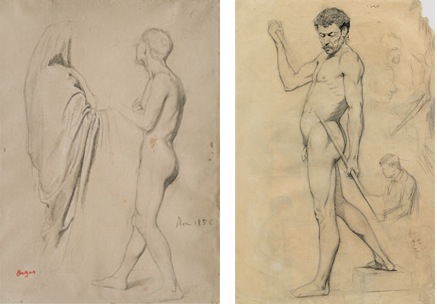The Clark – “Picasso Looks at Degas”
This is not your blockbuster, let’s get the bodies into the museum summer show; rather, it is a thought-provoking, intellectually engaging experience in contemplation, consideration, and connection. “Picasso Looks at Degas” is a magnificent exhibition...

Picasso looked at Degas all right – early on and often throughout his long and prolific career. The question is, what did he see and what did he do with what he saw? This major exhibition, tucked away in the Berkshire Hills of Massachusetts, answers those questions and far more.
The result of over ten years’ work by Elizabeth Cowling and Richard Kendall, curators at the Clark, and undertaken with the generous cooperation of the Museu Picasso in Barcelona and Picasso’s heirs, especially his grandson Bernard Ruiz-Picasso, “Picasso Looks at Degas” is an extraordinary and invigorating excursion into the mystery of creativity, at once an informative lecture and a caution about our own prejudices concerning what Harold Bloom has called “the anxiety of influence.”
Connections between Picasso and a number of his predecessors have been long acknowledged and fairly well researched-certainly the Old Masters of the European tradition, particularly Delacroix, Ingres, and Velasquez, since, despite impressions generated by the later work of the mature artist, Picasso was an academically-trained painter capable of producing works in the tradition. Likewise, connections between Picasso and the modern artists like Manet, Rodin, and Cezanne have been documented. But, though as early 1901 Monet, Pissarro, and Degas were advanced as likely influences on the iconoclastic Spaniard, until now, no one has explored any one of these three.
Picasso traveled to Paris several times before settling there in 1904. He and Degas became neighbors in Montmartre several years before Degas’ death in 1917; but they never met. And that is perhaps not so surprising. Though they frequented some of the same haunts (cafes, theatres, brothels) and shared a predilection for certain subject matter (ballerinas, prostitutes, cabaret singers, café habitués), they were vividly different characters. Certainly Picasso knew Degas’ work – how could he not, given their affinities? And though it seems to have been customary to focus on the year 1958, when Picasso purchased some of Degas’ work, as the moment of connection, “Picasso Looks at Degas,” with its witty, uncanny, and extraordinary juxtaposition of works by the two men from early on in Picasso’s career makes the case for much earlier influence and connection. And that – aside from the concept of the exhibition itself – is the genius of this show: patient, careful, and detailed laying out of an aesthetic and cultural argument in six galleries: to move through them in sequence is to follow the logical thread of argument from hypothesis to conclusion.

Gallery One provides an introduction and overview. Gallery Two, “Early Years: Drawing the Human Figure,” emphasizes the academic training of both artists and starts the sequence, beginning with self portraits set side-by-side, Picasso’s done when he was a mere fifteen years old, tousled-haired, melancholy, and introspective; Degas’s done at age 23, the image lacking the bravado of Picasso’s, but infused with the same wistful self-absorption, with the subject positioned so like Picasso’s. Of the other studies juxtaposed here, two sets stand out: Degas’s “Study for ‘Dante and Virgil’” (1856-7) and Picasso’s “Academic Study from Life: Male Nude. . .” (1895-97), each demonstrating sure, elegant line; and Degas’ “Standing Nude” (1860-65) alongside Picasso’s “Female Nude” (c.1899), both breathtaking in the artists’ ability to create sinuous line and shadow whether in pencil (Degas) or in charcoal (Picasso).
In Gallery Three, “Paris: Picasso Discovers Degas,” the canvases proliferate, pulsating with scenes of la vie Parisienne: theatre, café, cabaret, and the rather more intimate bathing scenes. Picasso had seen some of Degas’ pastels and painting on visits to Paris before he settled there and at very turn the influence of the older master shows. The viewer experiences the shock of similarity on seeing Picasso’s “The End of the Performance” (1901) in the same space as Degas’ monotype, “Café-Concert” (1878-80).

Gallery Four, “The Private World of Women,” focuses on representations of women bathing and arranging their hair. Degas had shown his models in real life settings going about ordinary, everyday activities; and his images were greatly simplified. Again the older painter’s influence is telling; in the years after Degas’ death, Picasso, time and again, returned to this very same subject matter. The debt of pose and composition is nowhere more telling than in the juxtaposed “Leaving the Bath” (Degas, 1879-80, dry point and aquatint) and “Woman in the Bath” (Picasso, 1921, pencil on paper).

Gallery Five, “The Ballet: Homage and Humor,” centres on Degas’ best-known sculpture, “Little Dancer Aged Fourteen” (1879-81), the only sculpture exhibited in public during the artist’s lifetime and emblematic of his longstanding interest in the world of ballet. The extent of that fascination became known only with the sale of the contents of his studio after his death (1917), when so many similar images were discovered. Paris was still under the spell of Diaghlev’s Ballets Russe and so was Picasso, particularly taken with the ballerinas, one of whom, Olga Khokhlova, would become his wife. Picasso’s preoccupation with creating images from the world of ballet for a decade or so reflects his very considerable debt to Degas. Just compare his “Two Dancers, 1919” with Degas’ “Three Ballet Dancers,” or Picasso’s “Three Ballet Dancers” (1919) with the latter and the verdict stands: Picasso’s artistic debt to Degas was considerable.

Gallery Six, “Brothel Scenes: The Artist as Voyeur,” is the most fascinating room in the Clark’s exhibition, not simply because of its erotic – perhaps pornographic for some – aura but moreso for the problem it presents in determining – ultimately – the relationship between Degas and Picasso. The works displayed in this gallery may well cause a re-evaluation of conclusions reached based on seeing what’s offered in the previous five. Between 1958 and 1960 Picasso bought nine provocative works by Degas for his own collection, a series of monotypes depicting scenes in a brothel. From all account, Degas was a straight-laced gentleman; it has been speculated than an early sexual adventure in which he may have aggressively raped a young woman caused trauma sufficient to render him permanently impotent. Whatever the case, he led a circumspect, chaste life and in that regard he could not have been more different from the priapic Picasso.

In 1971 Picasso began a series of variations on Degas’ monotypes and as the selection on offer indicates, ultimately determining the relationship between the two artists becomes highly problematic. Exactly what are these variations? Critique, homage, satire? Certainly it was a project that consumed Picasso’s prodigious energies; he worked on this series nearly up until his death in April 1973: speed, spontaneity, and incompleteness characterize the work. It is almost as if Picasso worked feverishly to finally articulate his relationship to Degas. Perhaps those fortunate enough to get to Williamstown to see “Picasso Looks at Degas” will find the answer.
This is not your blockbuster, let’s get the bodies into the museum summer show; rather, it is a thought-provoking, intellectually engaging experience in contemplation, consideration, and connection.
“Picasso Looks at Degas” is a magnificent exhibition carefully planned and designed to allow viewers to move from gallery to gallery with growing comprehension and appreciation for an argument-in-process. The exhibition lays out a focused, defined, limited, and convincing argument for the influence of the older artist on the younger, yes; but beyond that, it makes a larger argument about the mysterious, synergistic, sometimes ambiguous, not always comfortable, relationship between two acknowledged masters. The amplitude of evidence leaves the viewer – appropriately – not only with new knowledge of two great European painters but with questions to frame consideration of connections between other artists, specifically, perhaps, the unexplored relationship between Pissarro and Picasso as well as that between Monet and Picasso (the latter seems a natural, given the Clark’s Monet holdings, in another ten years). Meanwhile, get to the Clark. It is the only American venue for “Picasso Looks at Degas.” In the autumn it moves to the Museu Picasso in Barcelona. ![]()




